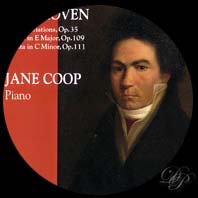| |
|
 |
|
|
| |
| |
|
This information has been published in the booklet of the cd: "Beethoven - Jane Coop, piano (Skylark)". Jane Coop wrote the presentation of the wroks. Many thanks to Skylark for their authorization for publishing these texts on the website. |
 |
|
|
|
By 1820, Beethoven had become a lonely man. His close friends had through one circumstance or another, been separated from him, and those who might have sought his company were deterred by the ever-growing rumours of his difficult and suspicious nature. Ironically, though, his enforced introspection opened still wider the doors of his imagination, so that his works now revealed an insight and beauty approaching the religious. The Sonata Op. 109 was conceived as the first of a group of three, though Op. 110 and 111 were not completed for another three years. The first movement takes a precedented form in its use of two contrasting tempi, but with an important difference: the usually slow introduction is here a Vivace, followed suddenly by Adagio espressivo. This fantastical second theme is virtually an improvisation, using the full breadth of the keyboard - arpeggios alternating with bare, widely spaced chords. Beethoven's genius for economy is brilliantly revealed in the tightly-knit second movement. Its excitement comes from not only its prestissimo tempo, but also the essential contribution of each and every note to the polyphonic texture. The variation movement is one of the most profound and ethereal works in the literature. Its serene theme, already a gem of simplicity in its original form, becomes throughout the variations more skeletal in nature and, at the same time, more florid and highly developed in texture. The six variations range from a pointillistic outline of the melody, to a flight based on a rising third, to an energetic fugato. The stirring final variation has almost no resemblance to the theme (which is quietly restated at the end), yet it seems to reveal, beneath its heavenly shimmer, the very essence of the entire work. |
|
|
|
The last seven years of Beethoven's life, while plagued with ill-health and financial frustration, were to encompass the most intensely creative period of his life. While still at work on the great Missa Solemnis as well as the Ninth Symphony, Beethoven began to compose his final, and in some ways his most profound piano sonata. For the overall form Beethoven returned to the two-movement scheme which, having worked well for some of his earlier, shorter works, now took on immense weight and significance. The contrasts between the two mammoth foundations are striking: fiery allegros vs serene adagios; tightly-knit sonata form vs exploratory variations; the dark key of C minor vs the tranquil key of C major; compressed fugal writing vs improvisatory wanderings; in essence, the concrete world of man vs the ethereal realm of spirituality. The Sonata opens with an intensity of passion which transcends anything Beethoven composed previously. The first lightening-bolt chord is far removed from the tonic key, a diminished seventh on the tritone of the scale, and that sets the character for the whole movement - one of torment and strife, carried along by hard, driving energy. The Arietta emerges from the glow of the previous movement, which has ended quietly in the major key, its passion and fervour spent. We now enter a new world - one of inner, spiritual contemplation. A set of variations, after proceeding seamlessly and gaining momentum and colour, is suddenly interrupted by a cadenza-like passage of solitary trills, high in the right hand. With the voices separated by a gaping five octaves, the piece comes to a standstill before sinking ecstatically into the final statement of the theme. At the end, we are drawn further and further into ourselves - and into the silence which follows. |
|
© Jane Coop
|
 |
|
|||||||||||||||||||